You’re spending more on electricity than you need to, and you probably don’t even know which devices are the biggest culprits. Home energy monitoring systems can change that by showing you exactly where every watt goes in real-time. These smart devices track your consumption patterns, identify energy hogs, and help you make informed decisions that’ll cut your bills considerably. The question isn’t whether you should monitor your energy use—it’s which system will give you the biggest impact.
What Are Home Energy Monitoring Systems and How Do They Work
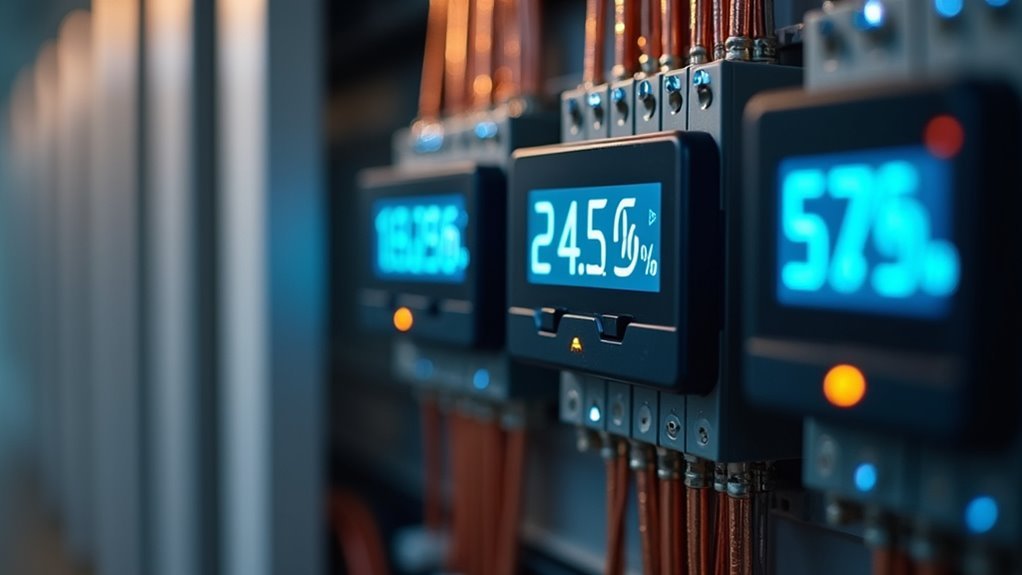
Home energy monitoring systems function as digital detectives for your household electricity consumption, continuously tracking and analyzing how much power your home uses throughout the day.
These systems provide real-time tracking of your energy consumption patterns, revealing exactly where your electricity dollars are going.
You’ll find two main types available: whole-home monitors that connect directly to your electrical panel to measure entire household usage, and individual appliance monitors that plug into specific outlets to track particular devices.
Both types collect detailed data about your power usage habits, allowing you to identify energy-hungry appliances and peak consumption periods.
With this information, you can implement targeted energy-saving strategies, adjust usage during expensive peak hours, and make informed decisions about replacing inefficient equipment.
Types of Energy Monitors: Whole-Home Vs Individual Appliance Tracking
When choosing an energy monitoring system, you’ll need to decide between whole-home monitors that track your entire household’s energy consumption and individual appliance monitors that focus on specific devices.
Whole-home systems connect directly to your electrical panel and provide a thorough overview of all circuits, while individual monitors plug into outlets to measure single appliances.
Each approach offers distinct advantages depending on whether you want broad energy insights or targeted device-specific data.
Whole-Home Monitor Benefits
While individual appliance monitors track specific devices one at a time, whole-home energy monitors offer a thorough solution that captures your entire household’s energy consumption from a single point at the electrical panel.
These systems provide several key advantages:
- Device Recognition Technology – They detect unique energy signatures of individual appliances, eliminating the need for multiple costly individual monitors while providing extensive insights.
- Real-Time Data Analysis – You’ll identify energy consumption spikes instantly, enabling immediate behavioral adjustments to avoid unnecessary costs and optimize energy usage patterns.
- Smart Integration – Monitors like the Emporia Vue offer mobile app connectivity for remote management and control.
For households with solar panel systems, whole-home energy monitors track consumption against solar production, maximizing renewable energy utilization and reducing utility bills.
Individual Appliance Tracking
Individual appliance monitors take a targeted approach, measuring energy consumption at the outlet level for specific devices throughout your home. Unlike whole-home energy systems that provide broad consumption overviews, these monitors focus on individual appliances to track energy precisely where it’s being used.
| Monitor Type | Best For | Key Feature |
|---|---|---|
| Kill-A-Watt | Single outlets | Detailed watt tracking |
| GreenSwitch | Multiple devices | Smart switching |
| Smart plugs | Remote control | App integration |
You’ll need multiple appliance monitors to achieve thorough coverage, making this approach more labor-intensive than whole-home energy monitoring. However, they’re excellent for identifying energy vampires and high-consumption devices. When you combine individual appliance tracking with whole-home systems, you’ll gain complete visibility into your household’s energy usage patterns.
Core Components That Make Energy Monitoring Possible
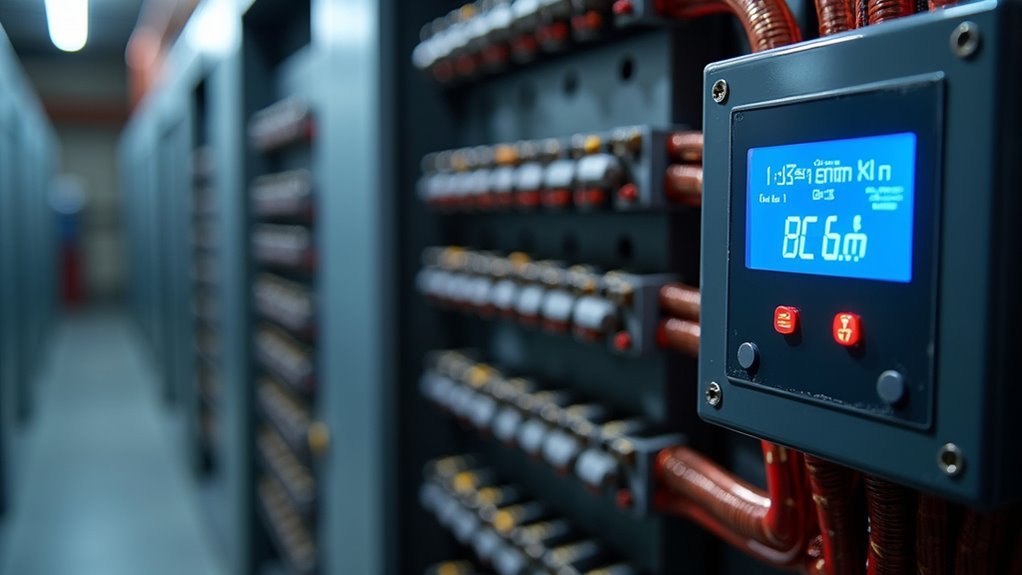
Three essential components form the backbone of any effective home energy monitoring system: smart meters that measure your overall electricity usage, in-home displays that present real-time consumption data, and software platforms that transform raw numbers into actionable insights.
Smart meters, real-time displays, and intelligent software platforms work together to create comprehensive home energy monitoring systems.
Here’s how these components work together:
- Smart meters connect directly to your electrical panel, functioning as whole-home monitors that track energy consumption across all circuits.
- Mobile app integrations enable remote monitoring and analysis, helping you develop energy-saving habits from anywhere.
- Predictive analytics capabilities analyze your usage patterns to identify future savings opportunities and optimize planning.
When integrated with smart home systems, these components enable automated energy management that continuously optimizes your home’s efficiency without requiring constant manual oversight.
Real-Time Data Features That Drive Energy Savings
When your energy monitoring system captures data in real-time, you’ll instantly see electricity spikes as they happen, transforming how you understand and control your home’s energy consumption.
You can track individual appliance consumption to identify which devices drain your wallet most, enabling smart upgrade decisions. Mobile integrations let you manage usage remotely, developing energy-efficient habits through immediate feedback.
Predictive analytics analyze your historical patterns, helping you budget effectively and plan for seasonal changes.
This continuous monitoring reveals hidden inefficiencies you’d otherwise miss, like phantom loads from electronics in standby mode. You’ll catch unusual spikes immediately, whether from a malfunctioning appliance or forgotten devices.
These real-time insights empower quick adjustments that compound into significant savings over time.
Smart Device Integration and Mobile App Capabilities
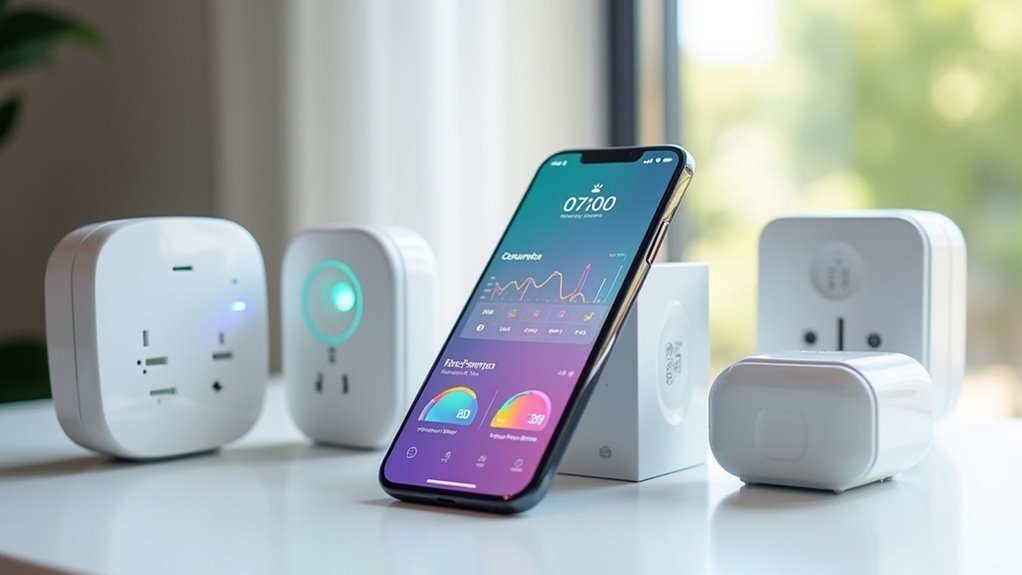
You’ll maximize your energy monitoring system’s potential by connecting it with smart home platforms like Amazon Alexa and Google Assistant for seamless voice control and automation.
Your mobile app becomes the command center where you can remotely manage appliances, track real-time usage, and receive instant alerts about energy spikes.
These integrated features transform scattered devices into a unified energy management ecosystem that responds to your voice commands and keeps you informed wherever you are.
Smart Home Platform Integration
While standalone energy monitors provide valuable data, integrating them with smart home platforms like Google Home and Amazon Alexa transforms how you interact with your energy consumption information.
You’ll gain centralized control through voice commands and unified interfaces that streamline your entire home’s energy management.
These energy monitoring systems work seamlessly with mobile apps to deliver real-time consumption data directly to your smartphone.
Advanced AI capabilities recognize individual appliances, providing tailored insights about your usage patterns.
Integration benefits include:
- Automated adjustments through smart thermostats and lighting systems based on your preferences
- Proactive management with energy usage goals and peak-time alerts
- Enhanced energy efficiency through machine learning that adapts to your lifestyle
You’ll make informed decisions from anywhere while optimizing your home’s performance.
Mobile App Features
Mobile apps serve as the command center for your home energy monitoring system, putting extensive control and detailed insights right in your pocket. You’ll access real-time energy usage data that reveals consumption patterns and identifies unexpected spikes instantly. Smart home devices integrate seamlessly, letting you schedule appliances during off-peak hours and automate energy-saving routines.
| Feature | Benefit |
|---|---|
| Real-time tracking | Monitor consumption patterns instantly |
| Smart device control | Automate appliances for cost savings |
| Predictive analytics | Plan future energy needs effectively |
Customizable dashboards visualize consumption by device category, enhancing your awareness of energy habits. You’ll receive alerts when appliances run unexpectedly or usage exceeds thresholds, enabling proactive energy management. This all-encompassing mobile control transforms energy management from reactive guesswork into informed decision-making.
Planning Your Energy Monitor Installation Strategy
Before diving into installation, consider your home’s unique energy profile and technical requirements to confirm you select the right monitoring system and approach.
Assess your specific energy needs and usage patterns first, determining whether whole-house monitoring or individual appliance tracking better suits your goals.
Next, decide between DIY installation and professional setup. While DIY saves money, professionals guarantee ideal sensor placement for accurate data collection.
Consider these key factors:
- Smart home technology integration – Confirm your energy monitoring system connects seamlessly with existing automation platforms.
- Solar power setups compatibility – Verify the monitor tracks both consumption and production if you have solar panels.
- Sensor placement optimization – Plan coverage for maximum effectiveness across your home’s electrical system.
DIY Setup Steps for Whole-House Energy Monitoring
Once you’ve planned your installation strategy, installing a whole-house energy monitoring system becomes a straightforward process that you can complete in a few hours.
First, select a compatible device like Emporia Vue or Sense for thorough energy monitoring. Before beginning, turn off your main power supply for safety, then mount the monitoring device securely to your electrical panel following manufacturer guidelines.
Always prioritize safety by turning off your main power supply before mounting any monitoring device to your electrical panel.
Configure the system using the accompanying mobile app, inputting your energy rates to track real-time energy consumption effectively.
Optimize sensor placement across all circuits for accurate readings of various appliances and devices.
Once installed, regularly analyze the data to identify usage patterns, peak consumption times, and opportunities for energy savings by adjusting your consumption habits.
Installing Individual Appliance Monitors and Smart Plugs
You’ll find individual appliance monitors and smart plugs offer the simplest entry point into home energy monitoring since they require no electrical work or technical expertise.
The setup process typically involves plugging the device into your wall outlet, downloading the manufacturer’s app, and connecting it to your Wi-Fi network within minutes.
Strategic placement of these monitors on your highest-consumption appliances like refrigerators, washing machines, and entertainment centers will give you the most valuable energy insights.
Smart Plug Setup Process
Smart plugs with energy monitoring capabilities offer the simplest entry point into home energy tracking, requiring no electrical expertise or complex installation procedures.
These devices from brands like Kill-A-Watt or Emporia make it easy to track energy consumption of individual appliances.
The setup process involves three straightforward steps:
- Physical Installation: Plug the smart plug into any standard outlet, then connect your desired appliance to the smart plug.
- App Configuration: Download the manufacturer’s mobile app and verify your Wi-Fi network is stable for seamless connectivity.
- Data Analysis: Use the app’s features to analyze energy usage patterns in real-time.
You’ll quickly identify energy hogs among your devices and discover opportunities for savings through adjusted usage schedules and improved consumption awareness.
Appliance Monitor Placement Tips
Strategic placement of your appliance monitors and smart plugs directly impacts monitoring accuracy and long-term convenience. Position these devices within close proximity to monitored appliances to maintain strong Wi-Fi signal strength for reliable data transmission. Place monitors where you can easily access them for resetting or maintenance, such as behind entertainment centers or near kitchen appliances.
| Placement Factor | Best Practice |
|---|---|
| Wi-Fi Signal | Keep monitors close to appliances and router |
| Accessibility | Position for easy resetting and unplugging |
| Power Management | Use extension cords with monitoring features |
Regularly adjust your appliance monitors’ settings to optimize energy consumption tracking. Consider smart plugs with scheduling capabilities to automate control during off-peak hours, maximizing energy efficiency while ensuring monitoring features accurately reflect each device’s usage patterns.
Configuring Your System for Maximum Accuracy
Once you’ve installed your energy monitoring system, proper configuration becomes critical for obtaining accurate readings that’ll help you make informed decisions about your home’s energy usage.
Energy monitors require specific setup procedures to deliver reliable accurate tracking of your energy consumption patterns.
Follow these essential configuration steps:
- Calibrate your devices according to manufacturer instructions to maintain precision over time and guarantee consistent data quality.
- Optimize sensor positioning to capture distinct energy signatures from different appliances, which improves monitoring accuracy considerably.
- Set up mobile app integrations to visualize real-time data and receive alerts for unusual energy spikes.
Continuously assess your system’s performance through historical tracking features, allowing you to identify trends and fine-tune configurations for improved monitoring effectiveness.
Reading and Understanding Your Energy Usage Data
Once you’ve configured your energy monitor correctly, you’ll need to interpret the wealth of data it provides to make meaningful changes to your consumption habits.
Start by familiarizing yourself with the basic metrics displayed on your device or app, including real-time usage rates, cumulative consumption, and cost calculations.
Learning to spot recurring patterns in your energy data will help you identify which appliances consume the most power and when your household’s demand peaks throughout the day.
Data Interpretation Basics
When you first look at your home energy monitor’s display, the abundance of numbers and graphs might seem overwhelming, but understanding these key data points will transform how you manage your household’s electricity consumption.
Your monitor tracks total kilowatt-hour consumption, showing overall energy usage patterns that help you identify long-term trends.
Focus on these essential metrics:
- Peak Usage Timing – Monitor when your electricity demand spikes throughout the day.
- Individual Appliance Usage – Identify which devices consume the most power.
- Real-time Cost Tracking – See how consumption translates into actual dollar amounts.
Historical data reveals your household’s energy patterns, enabling you to develop actionable strategies for reducing waste.
Identifying Usage Patterns
Three distinct patterns emerge when you analyze your home’s energy data over several weeks: daily cycles that show when your family uses electricity most heavily, weekly rhythms that differ between workdays and weekends, and seasonal shifts that reflect heating and cooling demands.
Your monitoring systems will reveal peak consumption times, typically during morning routines and evening activities.
You’ll spot weekend variations when families spend more time at home.
Appliance-level monitoring helps identify which devices drive these patterns—perhaps your water heater spikes every morning or your HVAC system dominates seasonal patterns.
Real-time data makes these trends visible instantly.
Watch for unusual spikes that indicate energy waste, like forgotten electronics or inefficient appliance settings.
Understanding these patterns enables you to shift high-demand activities to off-peak hours and reduce costs.
Identifying Energy Waste and High-Consumption Devices
While your monthly energy bill might seem like a mystery, home energy monitors reveal the hidden culprits behind those high costs. Through real-time tracking, you’ll discover which high-consumption devices are driving up your energy consumption and creating unnecessary energy waste.
Advanced energy monitoring systems can differentiate individual appliance signatures, showing you exactly when each device operates and how much power it uses.
Here’s what you’ll typically find:
- HVAC and refrigeration systems often account for over 50% of total home energy use.
- Older appliances frequently consume notably more power than newer, efficient models.
- Phantom loads from electronics in standby mode create continuous energy drain.
This detailed visibility helps you prioritize efficiency upgrades and adjust usage habits, potentially reducing your overall energy consumption by up to 20%.
Creating Automated Responses to Usage Patterns
Once you’ve identified your home’s energy consumption patterns, you can transform this data into intelligent automation that responds dynamically to your usage habits.
Smart home systems equipped with machine learning algorithms analyze your energy monitoring data to predict usage trends and automatically adjust devices like thermostats and lighting for maximum efficiency.
Machine learning transforms your home’s energy data into predictive automation that optimizes device efficiency without sacrificing comfort.
You can establish automated responses through energy monitoring apps that trigger actions during inactivity periods, such as dimming lights or powering down appliances.
Smart plugs and devices can be programmed to operate during off-peak hours when energy rates are lower, capitalizing on time-of-use pricing.
These automated systems continuously analyze usage patterns, generating alerts and adjustments that manage energy-intensive devices effectively, delivering substantial energy savings while maintaining comfort.
Calculating Your Return on Investment and Savings
Beyond simply reducing your energy consumption, understanding the financial impact of your monitoring system investment helps justify the upfront costs and guides future energy decisions.
Your energy monitoring system typically delivers considerable returns through multiple revenue streams:
- Immediate Bill Reduction – You’ll see 10-20% lower energy consumption within months of implementation, directly translating to reduced energy bills.
- Utility Rebates – Many companies offer rebates for energy monitoring installations, improving your return on investment greatly.
- Property Value Increase – Energy-efficient homes command 5-15% higher market values due to demonstrated lower utility costs.
Regular data analysis reveals ongoing savings opportunities, helping you continuously optimize consumption patterns.
Most homeowners recoup their initial investment within 1-3 years through these combined benefits.
Maintaining Your System for Long-Term Performance
Like any sophisticated technology investment, your home energy monitoring system requires consistent maintenance to deliver peak performance and maximize your long-term savings.
Start by installing software updates regularly to access the latest security improvements and features that enhance your energy management capabilities.
Regular software updates unlock enhanced security features and advanced energy management tools that optimize your system’s performance and capabilities.
Clean your sensors monthly to prevent dust buildup that could compromise accurate readings.
Check sensor placements after home renovations or appliance changes to maintain precise energy consumption tracking.
Review your energy data weekly to spot anomalies before they become costly problems. This proactive approach helps you identify inefficiencies quickly.
Consider integrating new smart devices as technology advances.
Adding smart thermostats or updated energy management software expands your system’s capabilities, ensuring it continues meeting your evolving energy monitoring needs effectively.
Frequently Asked Questions
How Can I Monitor My Whole House Electricity?
You can install a whole-home energy monitor that attaches to your electrical panel. These devices track real-time consumption, detect device signatures, and provide mobile app insights to help you reduce costs.
Can I Get a Free Energy Monitor?
You can often get free energy monitors through your utility company’s efficiency programs, government initiatives, non-profit organizations, or manufacturer promotions. Check with your local utility provider or search for community energy programs.
Is a Home Energy Monitor Worth It?
You’ll likely find a home energy monitor worth it if you’re motivated to reduce utility bills. They’ll help you identify energy waste, make informed appliance decisions, and develop efficient habits that save money long-term.
How Many Hours Does a Home Energy Score Take to Complete on Average?
You’ll spend 1 to 2 hours completing a Home Energy Score assessment. The duration depends on your home’s size and complexity, as assessors thoroughly examine insulation, heating systems, and appliances using specialized measurement tools.

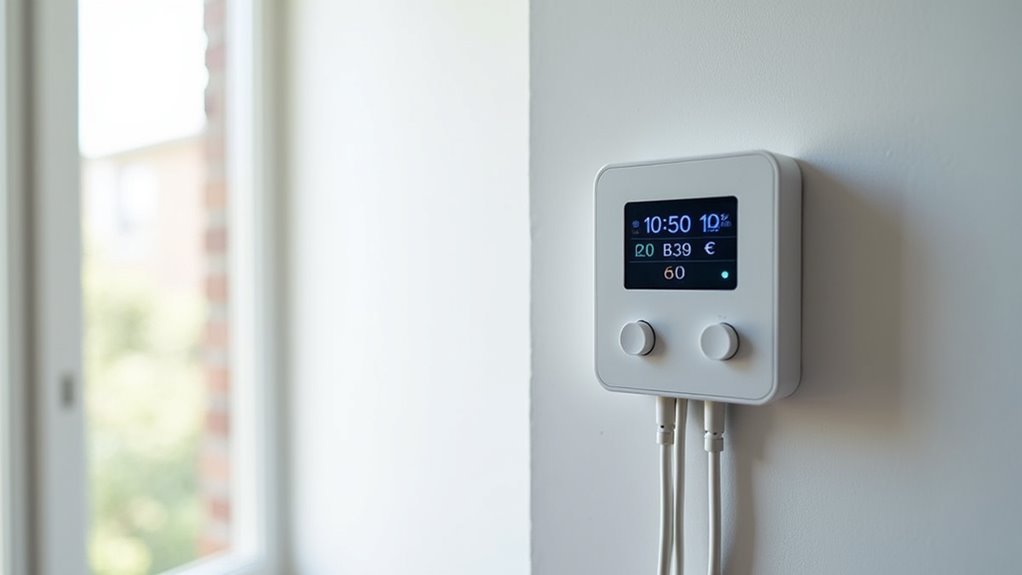
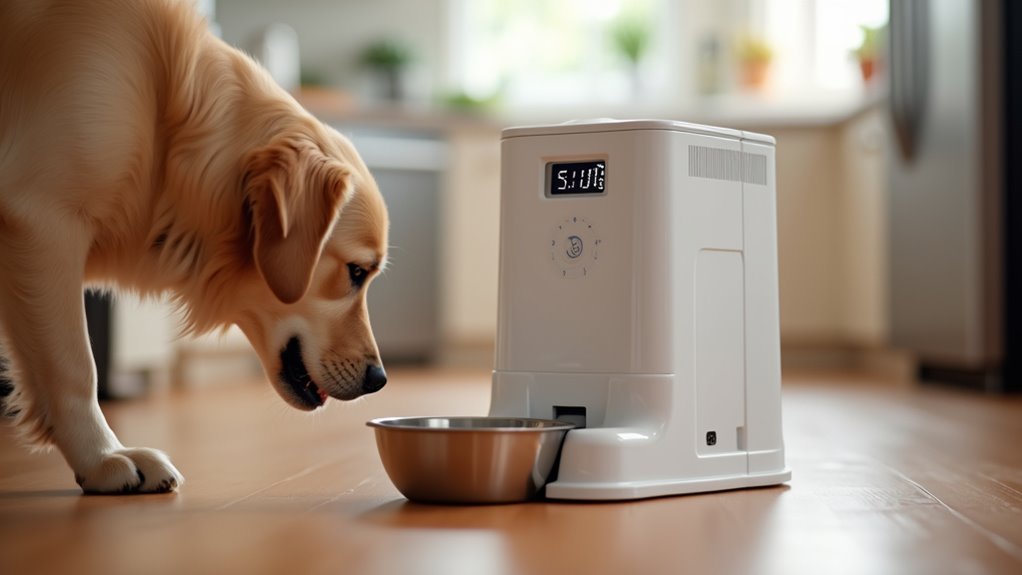
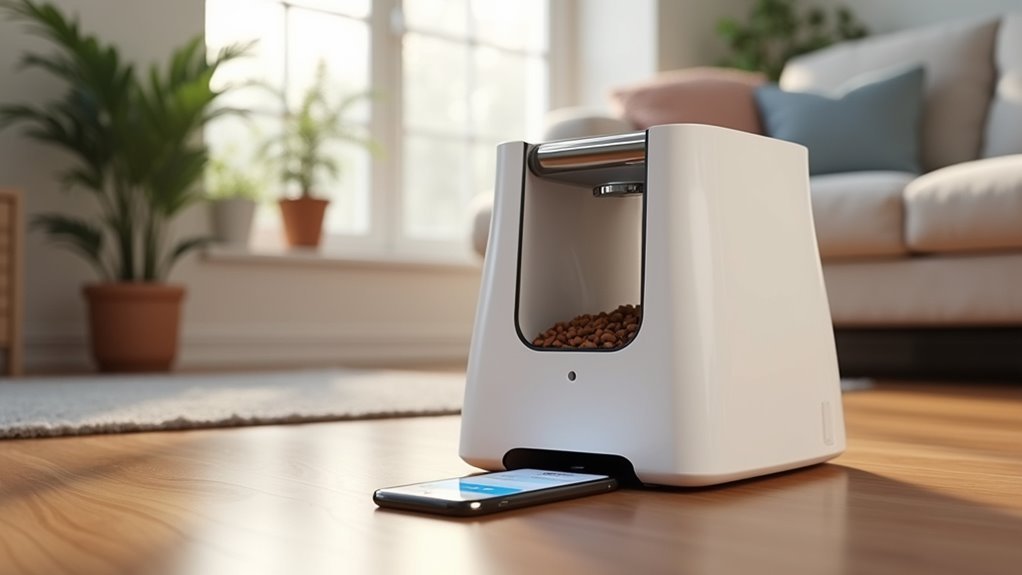

Leave a Reply